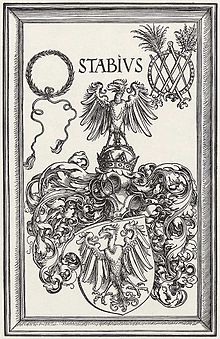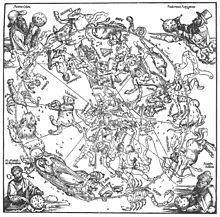Johannes Stabius
Johannes Stabius (* before about 1468 in Hueb bei Steyr , Duchy of Austria ; † January 1, 1522 in Graz ) was a humanist , scientist and historiographer .
Origin and career
Johannes Stabius (von Stöberer , not von Stab ) was born in Hueb, an unspecified place near Steyr in Upper Austria, presumably the son of a forester. We have little news about his youth. In 1482 he was enrolled at the University of Ingolstadt , and in 1484 he obtained the Baccalaureat there . After years of traveling, which took him to Nuremberg and Vienna , among other places , he taught as a professor of mathematics in Ingolstadt from 1498 on. As a priest he had the parish of Karlstetten in Lower Austria around 1500 .
Konrad Celtis , who had taught in Ingolstadt since 1492, brought Stabius to the University of Vienna in 1502 . His student Georg Tannstetter also went there . In 1514, he added a history of Viennese mathematicians and astronomers to his edition of astronomical tables under the title Viri Mathematici . In it he described himself as a student of Stabius and led his "mathematical inventions".
In the summer of 1503, Stabius entered the service of the Roman-German king and later emperor Maximilian I , whom he accompanied on trips and whom he advised on scientific and literary questions. The university soon faded into the background.
Stabius as a man of letters and historian
Stabius was known to numerous scholars and poets with a humanistic education, such as Ladislaus Sunthaym or Jakob Mennel , and was friends with Albrecht Dürer . Dürer designed his coat of arms and portrayed him several times. He was also active as a poet. In 1502 he was therefore crowned poeta laureatus by Celtis . He stepped forward with odes to the emperor and Austrian saints and, together with Willibald Pirckheimer, designed the allegorical framework for the triumphal procession and the gate of honor , in which the political concept of Maximilian I was propagated. For example, the verses on the honor gate , which Albrecht Dürer illustrated, come from Stabius.
In addition, he worked as an editor or contributor to numerous humanistic works and obtained an edition of the Jordanes . He rejected uncritical historical research and exposed the works of Johannes Trithemius as partially fictitious. Stabius worked with Ladislaus Sunthaym and Konrad Celtis on the semi-official Habsburg history work and created, among other things, a genealogy of the Habsburgs based on sources.
Stabius also seems to have had good relations with Reichenau Monastery . In any case, on a visit to Johannes Cuspinian , he loaned a Carolingian composite manuscript with texts by the church fathers (which has since disappeared).
Stabius as a geographer and astronomer
But his most important achievement was in the field of cartography with the first true-to-area representation of the globe. This so-called stab- Werner heart-shaped projection was not published in print until 1514 by Johannes Werner (1468–1528), but it was already used by Martin Waldseemüller for his world map from 1507. As Johannes Werner himself confessed, the main part of this innovation, which for the first time went beyond the representation method of antiquity , comes from Stabius. It was widely used in the first half of the 16th century, but was then replaced by the Mercator projection .
In 1515 the world map by Dürer and Stabius ( Stabius-Dürer map ) and the star maps by Dürer, Stabius and Konrad Heinfogel were published .
The calculation of sundials is based on a similar projection task. Together with Johannes Werner, he calculated the sundial on the east choir of the Lorenz Church in Nuremberg.
The last few years
Although Stabius was a clergyman - he had a rich benefice at St. Stephen's Cathedral - he was knighted by Maximilian in 1515 because of his achievements. After the emperor's death in 1519, he entered the service of Archduke Ferdinand von Habsburg for a short time . During this time he was mostly in Augsburg , Ingolstadt or Nuremberg . He died on January 1, 1522 in Graz .
literature
- Jan-Dirk Müller: Gedechtnus. Literature and court society around Maximilian I. Munich 1982, ISBN 3-7705-1830-6 , p. 59 and often.
- Maximilian I. Exhibition catalog. Innsbruck 1969.
- Helmuth Großing: Johannes Stabius. An Upper Austrian among the humanists around Emperor Maximilian. In: Communications from the Upper Austrian Provincial Archives. Volume 9, Linz 1968, pp. 239–264, pp. 239–251 (PDF; 3.6 MB) in the forum OoeGeschichte.at and pp. 252–264 (PDF; 4.5 MB) in the forum OoeGeschichte.at.
- Helmuth Grössing: Stabius, Johannes. In: Archive of the history of the natural sciences (continuation of the lexicon started by Josef Mayerhöfer) 8/9, 1983, pp. 453–455.
- Siegmund Günther: The fate of geography in Nuremberg . In: Treatises of the Natural History Society in Nuremberg. Volume 17, 1907, pp. 1-20 (here pp. 7-8).
- Franz von Krones: Stabius, Johannes . In: Allgemeine Deutsche Biographie (ADB). Volume 35, Duncker & Humblot, Leipzig 1893, p. 337.
- Karl Röttel: Stabius, Johannes. In: New German Biography (NDB). Volume 24, Duncker & Humblot, Berlin 2010, ISBN 978-3-428-11205-0 , pp. 777 f. ( Digitized version ).
- Günther Hamann : The Behaim globe as a model for the Stabius Dürer map from 1515. In: Der Globusfreund. No. 25/27, 1977/79 (published 1978), pp. 135-147.
Individual evidence
- ↑ Ed. And translated in Franz Graf-Stuhlhofer : Humanism between Court and University. Georg Tannstetter (Collimitius) and his scientific environment in Vienna in the early 16th century . Vienna 1996, p. 156–171 (there p. 164 f.).
- ↑ The Reichenau manuscripts , described and ext. by Alfred Holder. Continued by Karl Preisendanz , Vol. 3, Karlsruhe 1918 (The manuscripts of the Grand Ducal Badische Hof- und Landesbibliothek in Karlsruhe 7), p. 92.
- ^ Astronomy in Nuremberg. The world map by Dürer and Stabius from 1515 , accessed on December 10, 2013
- ^ Astronomy in Nuremberg. Albrecht Dürer's star maps from 1515 , accessed on December 10, 2013
- ^ Astronomy in Nuremberg. Profile of Konrad Heinfogel , accessed on December 10, 2013
Web links
- Johannes Stabius in the repertory "Historical Sources of the German Middle Ages"
- Astronomy in Nuremberg. Profile of Johannes Stabius
| personal data | |
|---|---|
| SURNAME | Stabius, Johannes |
| BRIEF DESCRIPTION | Humanist, scientist and historiographer |
| DATE OF BIRTH | around 1460 |
| PLACE OF BIRTH | Hueb near Steyr |
| DATE OF DEATH | January 1, 1522 |
| Place of death | Graz |



